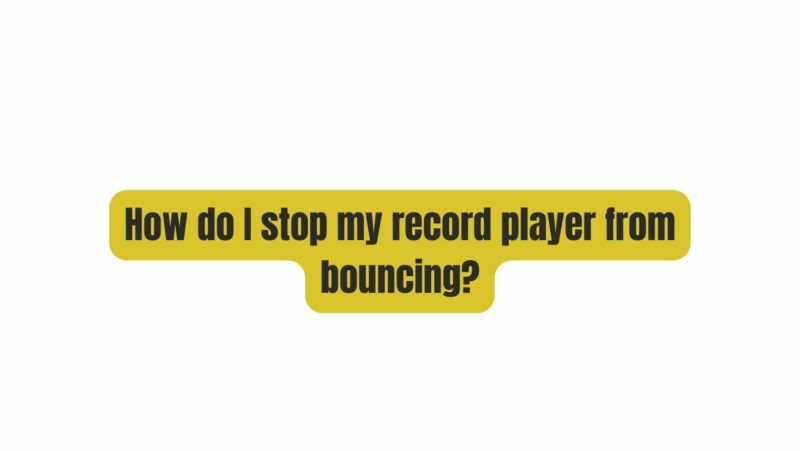The allure of vinyl records lies in their unparalleled ability to immerse us in the pure, warm tones of music as it was meant to be heard. However, the experience can quickly turn sour when your record player needle starts to bounce, causing frustrating interruptions and potential damage to your cherished vinyl collection. In this comprehensive guide, we will explore the reasons behind the bouncing needle phenomenon and provide you with step-by-step solutions to ensure that your record player delivers smooth, uninterrupted playback.
Section 1: Understanding the Mechanics of Record Playback
Before diving into the solutions, it’s essential to grasp the basic mechanics of how a record player operates and how the needle interacts with the grooves of your vinyl records.
1.1 The Anatomy of a Record Player
A typical record player consists of several essential components:
- Turntable Platter: The circular platform on which the record sits and rotates.
- Tonearm: The arm that holds the cartridge and stylus and guides it along the record grooves.
- Cartridge: The housing that contains the stylus (needle) and the electrical components responsible for converting the vibrations into sound.
- Stylus (Needle): The tiny, delicate component that tracks the grooves of the record, reading the musical information encoded within.
- Counterweight: A balance mechanism on the tonearm used to set the tracking force.
1.2 The Grooves of a Vinyl Record
Vinyl records contain grooves that represent the musical information. When the stylus follows these grooves, it generates vibrations that are converted into sound. Any disruptions in this process can lead to a bouncing needle.
Section 2: Diagnosing the Problem
To resolve the issue of a bouncing needle, you first need to pinpoint the root cause. Here are some common reasons why your needle might be bouncing:
2.1 Incorrect Tracking Force
Tracking force refers to the amount of weight or pressure the stylus exerts on the record’s surface. Too much or too little tracking force can cause tracking problems, including needle bounce.
2.2 Tonearm Balance Issues
A misbalanced tonearm can affect the stylus’s ability to track the grooves smoothly. If your tonearm isn’t correctly balanced, it can cause the needle to skip.
2.3 Record Condition
Scratches, dust, or debris on your records can disrupt the stylus’s path, leading to needle bounce.
2.4 Worn Stylus
Over time, the stylus on your cartridge can wear down, affecting its ability to maintain proper contact with the grooves.
2.5 Turntable Leveling
An uneven turntable surface can lead to tracking problems, including needle bounce.
2.6 Anti-Skate Adjustment
The anti-skate setting helps counteract the lateral force pulling the stylus towards the center of the record. Incorrect anti-skate settings can result in tracking issues.
2.7 Tonearm Wiring and Connections
Loose or damaged tonearm wiring and connections can disrupt the signal path, leading to needle bounce.
2.8 Record Player Setup
Improper setup, including cartridge alignment and tonearm height adjustment, can contribute to tracking problems.
2.9 Record Warping
Warped records can cause the needle to bounce as it struggles to follow the uneven surface of the vinyl.
2.10 Suboptimal Cartridge Compatibility
Mismatched cartridges and tonearms can lead to tracking issues.
Section 3: Solutions to Prevent Needle Bounce
Now that we’ve identified the potential causes of needle bounce, let’s delve into practical solutions to ensure your record player delivers a flawless listening experience.
3.1 Adjusting Tracking Force
Proper tracking force is critical for smooth playback. Consult your turntable’s manual or cartridge specifications to determine the correct tracking force for your setup. Use a stylus force gauge to make precise adjustments to the tonearm’s counterweight.
3.2 Balancing the Tonearm
Achieving the correct balance of your tonearm is crucial. Follow your turntable’s manual to ensure the tonearm is properly balanced. This step is often overlooked but can significantly impact playback quality.
3.3 Record Maintenance
Regularly clean and inspect your vinyl records to prevent dust, debris, and scratches. Invest in a carbon fiber brush and a record cleaning solution to keep your records in optimal condition.
3.4 Stylus Replacement
Monitor the condition of your stylus and replace it when it shows signs of wear or damage. A well-maintained stylus ensures precise tracking and prevents needle bounce.
3.5 Leveling Your Turntable
Place your turntable on a stable and level surface. Use a bubble level to confirm that it’s perfectly balanced. Adjust the turntable’s feet or use isolation pads to achieve the desired level.
3.6 Anti-Skate Adjustment
Consult your turntable’s manual for guidance on setting the correct anti-skate adjustment. Proper anti-skate settings help maintain balance and prevent unwanted lateral movement of the stylus.
3.7 Checking Tonearm Wiring and Connections
Inspect the tonearm wiring and connections to ensure they are secure and undamaged. Repair or replace any faulty components as necessary.
3.8 Proper Record Player Setup
Invest time in setting up your turntable correctly, including accurate cartridge alignment and tonearm height adjustment. A well-calibrated setup ensures optimal tracking and playback.
3.9 Handling Warped Records
Avoid playing severely warped records, as they can damage your stylus and lead to needle bounce. Store your records upright and in a controlled environment to prevent warping.
3.10 Ensuring Cartridge Compatibility
Confirm that your cartridge is compatible with your turntable’s tonearm and is properly mounted. Upgrading components for better compatibility can significantly improve tracking performance.
Section 4: Conclusion
In conclusion, a bouncing needle on your record player can be a frustrating obstacle to your vinyl listening pleasure, but it’s not an insurmountable one. Understanding the mechanics of record playback and addressing common issues such as tracking force, tonearm balance, record maintenance, and setup can help you enjoy uninterrupted, high-quality sound from your vinyl collection. By following the solutions outlined in this guide, you can ensure that your record player operates smoothly, preserving your records and delivering the nostalgia and warmth of analog music that vinyl enthusiasts cherish.


